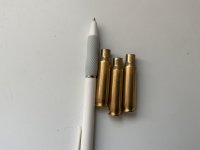hi. Yes, I'm new here. I have a question that is not necessarily related to reloading but the folks here are probably the best equipped to answer intelligently.
I have two semi-auto 308 rifles. I recently shot a box of factory ammunition 10 rounds through each rifle. The brass length measures around 2.022 from one and 2.005 or less from the other. Both rifles are new, less than 200 rounds through each. I’m starting to believe that my first rifle is not properly chambered but I’m not certain what exactly is incorrect. Yes I understand that these are two separate rifles from different manufacturers and the chambers will be different. There aren’t any signs of excessive pressure on the brass or primers. I am reloading and I am not looking forward to trimming brass after each firing. Has anyone had a similar issue or know what may wrong with my first rifle?
I have two semi-auto 308 rifles. I recently shot a box of factory ammunition 10 rounds through each rifle. The brass length measures around 2.022 from one and 2.005 or less from the other. Both rifles are new, less than 200 rounds through each. I’m starting to believe that my first rifle is not properly chambered but I’m not certain what exactly is incorrect. Yes I understand that these are two separate rifles from different manufacturers and the chambers will be different. There aren’t any signs of excessive pressure on the brass or primers. I am reloading and I am not looking forward to trimming brass after each firing. Has anyone had a similar issue or know what may wrong with my first rifle?


